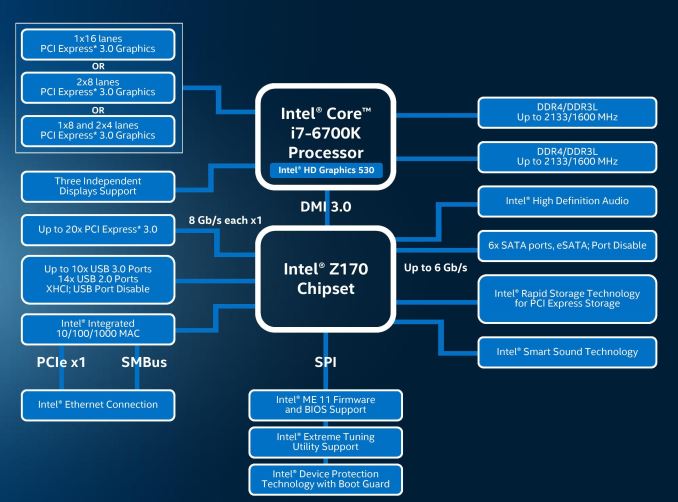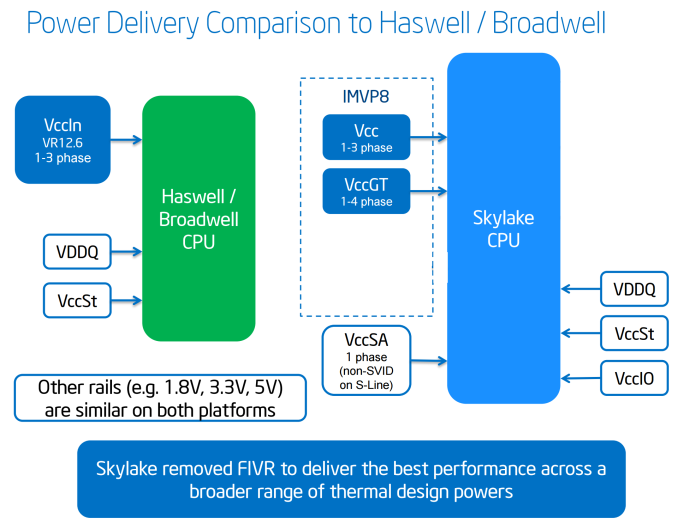The Intel 6th Gen Skylake Review: Core i7-6700K and i5-6600K Tested
by Ian Cutress on August 5, 2015 8:00 AM ESTThe Skylake CPU Architecture
As with any new Intel architecture, the devil is in the details. Previously at AnandTech we have been able to provide deep dives into what exactly is going on in the belly of the beast, although the launch of Skylake has posed a fair share of problems.
Nominally we rely on a certain amount of openness from the processor/SoC manufacturer in providing low level details that we can verify and/or explain. In the past, this information has typically been provided in advance of the launch by way of several meetings/consultations with discussions talking to the engineers. There are some things we can probe, but others are like a black box. The black box nature of some elements, such as Qualcomm’s Adreno graphics, means that it will remain a mystery until Pandora’s box is opened.
In the lead up to the launch of Intel’s Skylake platform, architecture details have been both thin on the ground and thin in the air, even when it comes down to fundamental details about the EU counts of the integrated graphics, or explanations regarding the change in processor naming scheme. In almost all circumstances, we’ve been told to wait until Intel’s Developer Forum in mid-August for the main reason that the launch today is not the full stack Skylake launch, which will take place later in the quarter. Both Ryan and I will be at IDF taking fastidious notes and asking questions for everyone, but at this point in time a good portion of our analysis comes from information provided by sources other than Intel, and while we trust it, we can't fully verify it as we normally would.
As a result, the details on the following few pages have been formed through investigation, discussion and collaboration outside the normal channels, and may be updated as more information is discovered or confirmed. Some of this information is mirrored in our other coverage in order to offer a complete picture in each article as well. After IDF we plan to put together a more detailed architecture piece as a fundamental block in analyzing our end results.
The CPU
As bad as it sounds, the best image of the underlying processor architecture is the block diagram:
From a CPU connectivity standpoint, we discussed the DDR3L/DDR4 dual memory controller design on the previous page so we won’t go over it again here. On the PCI-Express Graphics allocation side, the Skylake processors will have sixteen PCIe 3.0 lanes to use for directly attached devices to the processor, similar to Intel's previous generation processors. These can be split into a single PCIe 3.0 x16, x8/x8 or x8/x4/x4 with basic motherboard design. (Note that this is different to early reports of Skylake having 20 PCIe 3.0 lanes for GPUs. It does not.)
With this, SLI will work up to x8/x8. If a motherboard supports x8/x4/x4 and a PCIe card is placed into that bottom slot, SLI will not work because only one GPU will have eight lanes. NVIDIA requires a minimum of PCIe x8 in order to enable SLI. Crossfire has no such limitation, which makes the possible configurations interesting. Below we discuss that the chipset has 20 (!) PCIe 3.0 lanes to use in five sets of four lanes, and these could be used for graphics cards as well. That means a motherboard can support x8/x8 from the CPU and PCIe 3.0 x4 from the chipset and end up with either dual-SLI or tri-CFX enabled when all the slots are populated.
DMI 3.0
The processor is connected to the chipset by the four-lane DMI 3.0 interface. The DMI 3.0 protocol is an upgrade over the previous generation which used DMI 2.0 – this upgrade boosts the speed from 5.0 GT/s (2GB/sec) to 8.0 GT/s (~3.93GB/sec), essentially upgrading DMI from PCIe 2 to PCIe 3, but requires the motherboard traces between the CPU and chipset to be shorter (7 inches rather than 8 inches) in order to maintain signal speed and integrity. This also allows one of the biggest upgrades to the system, chipset connectivity, as shown below in the HSIO section.
CPU Power Arrangements
Moving on to power arrangements, with Skylake the situation changes as compared to Haswell. Prior to Haswell, voltage regulation was performed by the motherboard and the right voltages were then put into the processor. This was deemed inefficient for power consumption, and for the Haswell/Broadwell processors Intel decided to create a fully integrated voltage regulator (FIVR) in order to reduce motherboard cost and reduce power consumption. This had an unintended side-effect – while it was more efficient (good for mobile platforms), it also acted as a source of heat generation inside the CPU with high frequencies. As a result, overclocking was limited by temperatures and the quality of the FIVR led to a large variation in results. For Skylake on the desktop, the voltage regulation is moved back into the hands of the motherboard manufacturers. This should allow for cooler processors depending on how the silicon works, but it will result in slightly more expensive motherboards.
A slight indication of this will be that some motherboards will go back to having a large amount of multiplexed phases on the motherboard, and it will allow some manufacturers to use this as a differentiating point, although the usefulness of such a design is sometimes questionable.












477 Comments
View All Comments
zShowtimez - Wednesday, August 5, 2015 - link
With 0 competition at the high end, its not really a surprise.Refuge - Wednesday, August 5, 2015 - link
^this^darkfalz - Wednesday, August 5, 2015 - link
Yeah, sad. Single digit generational IPC improvements and a trickle up of clockspeed - not exactly exciting times in the CPU world. But I'm kind of happy, in a way, as who wants to have to upgrade their whole system rather than just the GPU every 2 years. It strikes me that Intel are doing a pissload of work for very little results though.wallysb01 - Wednesday, August 5, 2015 - link
What’s lost is that these gains are coming with roughly zero increased power draw. Much of the gains of years past were largely due to being able to increase the power consumption without melting things. Today, we’ve picked all the low hanging fruit in that regard. There is just no point in being disappointed in 5-10% increases in performance, as time moves on its only going to get worse.There is also no point in getting mad at AMD for not providing competition to push intel or at Intel for not pushing themselves enough. If added performance was easy to come by we’d see Intel/AMD or some random start up do it. The market is huge and if Intel could suddenly double performance (or cut power draw in half with the same performance) they would do it. They want you to replace your old Intel machine with a new one just as much as they want to make sure your new computer is Intel rather than AMD.
boeush - Thursday, August 6, 2015 - link
And yet, one would expect much lower operating voltage and/or much higher base clocks with a new architecture on a 14nm process, as compared to the 22nm Haswell. The relatively tiny improvements in everything except iGPU speaks to either misplaced design priorities (i.e. incompetence) or ongoing problems with the 14nm process...Achaios - Wednesday, August 5, 2015 - link
Very often. You are simply NOT a gamer. There are games that depend almost completely on CPU single threaded performance: World of Warcraft, Total War series games, Starcraft II, etc.Nagorak - Wednesday, August 5, 2015 - link
The games you listed aren't ones where I'd think having hundreds of FPS would be necessary.jeffkibuule - Thursday, August 6, 2015 - link
FPS can vary wildly because so many units end up on screen.vdek - Thursday, August 6, 2015 - link
I'm a gamer, I plan a ton of SCII, my Xeon 5650 6 core @ 4.2 ghz does just fine on any of those mentioned games. Why should I upgrade?Kjella - Wednesday, August 5, 2015 - link
Yeah. I upgraded from the i7-860 to the i7-4790K, the only two benchmarks they have in common in Bench suggests that's roughly a 100% upgrade. And a lot of that is the huge boost to base clock on the 4790 vs the 4770, I prefer running things at stock speed since in my experience all computers are a bit unstable and I'd rather not wonder if it's my overclocking..
At this rate it looks like any Sandy Bridge or newer is basically "use it until it breaks", at 5-10% increase/generation there's no point in upgrading for raw performance. 16GB sticks only matter if you want more than 4x8GB RAM. PCIe 3.0 seems plenty fast enough. And while there's a few faster connectors, that's accessories. The biggest change is the SSD and there you can always add an Intel 750 PCIe card instead for state of the art 4x PCIe 3.0 NVME drive. Makes more sense than replacing the system.